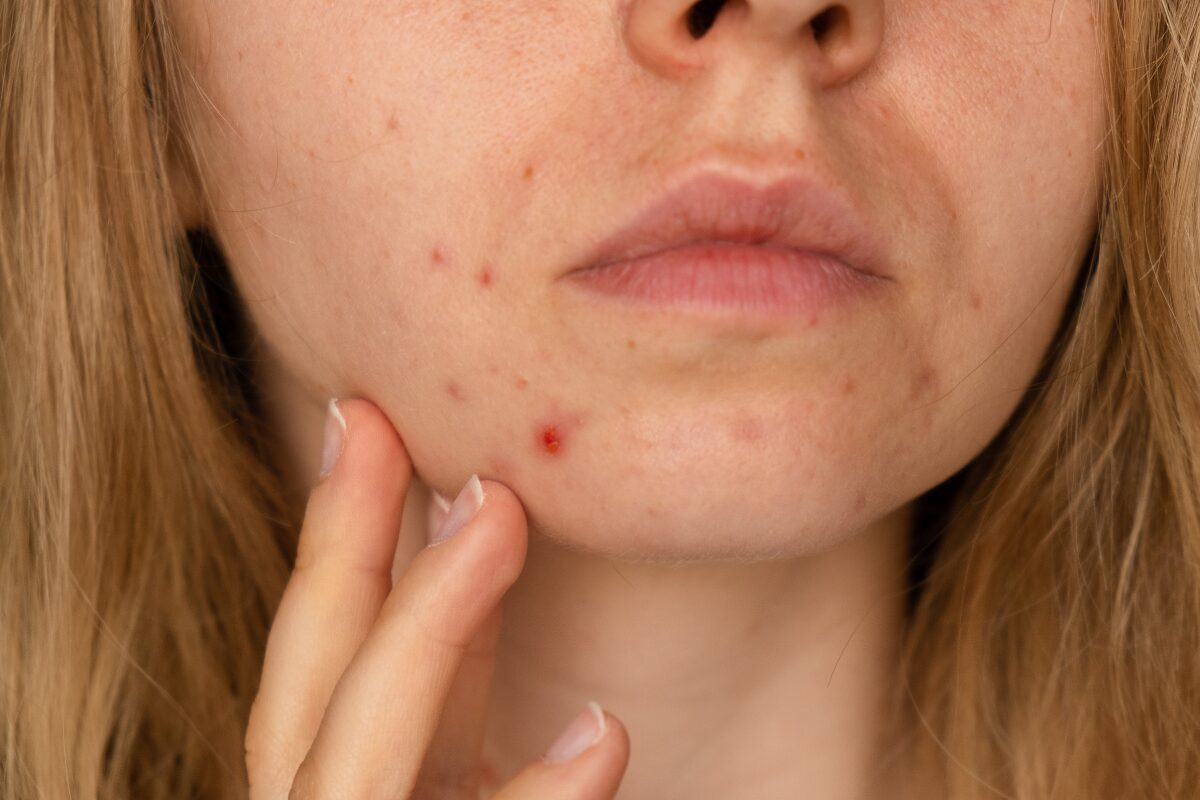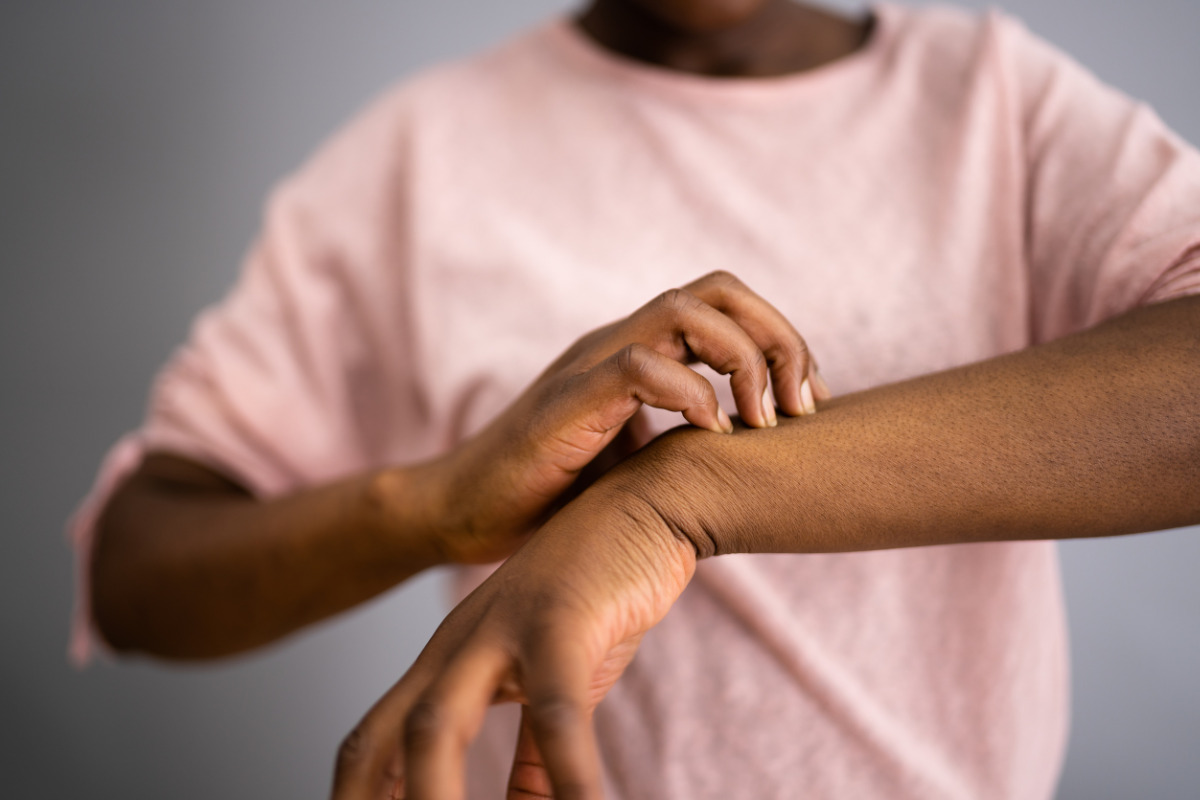Managing Dry Skin in Midlife & Menopause

Even if you’ve cultivated an ideal skin routine during your adult life, midlife and menopause can throw a wrench in it. Most women will have to adapt to skin changes, including a shift towards dryer skin. You know that menopause affects a majority of your body systems, but why does it change your skin—and what can you do about it?
Causes of Dry Skin in Menopause
Dry skin, medically known as xerosis, can result from a combination of factors. Unsurprisingly, the primary contributor to skin changes in midlife is a drop in estrogen.
Estrogen is like the body’s natural moisturizer. It stimulates the production of collagen and elastin, two proteins vital for skin’s firmness and elasticity. Progesterone and testosterone regulate sebum, the skin’s natural oil. This balancing act ensures that your skin stays supple, hydrated, and protected.
As you enter menopause, estrogen and progesterone production significantly decreases. Testosterone also declines steadily with age. This hormonal shift triggers a cascade of changes in your body, including your skin. With less estrogen, your skin loses its ability to hold moisture effectively and becomes drier.
Estrogen also influences the production of collagen and hyaluronic acid, both essential for skin hydration. Collagen provides structure, while hyaluronic acid retains moisture. With estrogen on the decline, these substances become less abundant, contributing to dry, less plump skin.
Non-Hormonal Factors
While hormonal fluctuations play a pivotal role in developing dry skin during menopause, several non-hormonal contributors can exacerbate this condition.
1. Aging. Regardless of hormonal changes, aging itself causes your skin to change. The skin’s natural barrier weakens, making it more susceptible to dryness, environmental factors, and dehydration.
2. Environmental factors. Exposure to harsh weather conditions, low humidity levels, and air conditioning can strip the skin of moisture. Additionally, indoor heating during the colder months can further contribute to dryness.
3. Excessive cleansing and exfoliating. Overzealous cleansing or using harsh soaps and cleansers can disrupt the skin’s natural lipid barrier, leading to moisture loss. Choose gentle, hydrating cleansers and avoid excessive scrubbing.
4. Hot showers and baths. While hot water can be soothing, it can also strip the skin of its natural oils. Long, hot showers or baths should be avoided, especially if you’re prone to dry skin.
5. Lifestyle. Smoking and excessive alcohol consumption can dehydrate the skin and contribute to dryness. Smoking narrows blood vessels in the outermost layers of the skin, reducing blood flow and nutrients to the skin.
6. Medications. Some medications, such as diuretics and antihistamines, can have drying effects on the skin. If you suspect a medication may be contributing to your dry skin, consult your healthcare provider for alternatives.
Improve Your Skin Health with Lifestyle Changes
With a better understanding of both hormonal and non-hormonal contributors to dry skin during menopause, let’s explore comprehensive lifestyle changes to support your skin:
1. Hydration is key. Ensure you drink an ample amount of water daily. Hydration from within helps maintain your skin’s moisture balance. Experts recommend that adult women consume 2.7 liters of water per day. Track your water intake for a day. How far are you from this target?
2. A nutrient-rich diet. Opt for foods rich in essential fatty acids, antioxidants, and vitamins. Omega-3 fatty acids found in fatty fish, flaxseeds, and walnuts promote skin health. Antioxidant-rich berries, oranges, and leafy greens can help protect your skin from oxidative stress, the process by which aging and environmental stress damages your cells.
3. Gentle cleansing. If you’re struggling with your skin, it’s tempting to do more—but dry skin needs a break from products that disrupt its natural moisture barrier. Choose a mild, hydrating cleanser that doesn’t strip your skin of essential oils. Avoid vigorous scrubbing and opt for gentle patting to dry your skin.
4. Swap your products. Besides a gentle cleanser, it’s time to re-evaluate all your skincare and cosmetic products. Likely, they are not serving your new, dryer skin. It can be confusing to select new products after years of relying on your tried and true items. We outline a few tips below, and you can also consult with an esthetician or dermatologist.
5. Lukewarm showers. Hot water can exacerbate dryness. Choose lukewarm water for your showers and baths to protect your skin’s natural oils. Consider adding colloidal oatmeal to your bath for soothing relief.
6. Humidify your environment. Using a humidifier in your home can add moisture to the air, benefiting your skin. Make sure to clean it regularly to prevent mold growth.
7. Sleep and stress management. A stressed and tired body is a recipe for skin issues. Take care of the fundamentals so your body can recover from your day.
8. Regular exercise. Regular physical activity promotes blood flow to the skin. Don’t be afraid to push the intensity and really get your heart pumping. Just remember to shower promptly afterward and moisturize to prevent dryness.
9. Lifestyle boost. Consider quitting smoking and dialing back on alcohol.
Skincare Products for Dry Skin
With all the choices out there, it’s hard to know which products are best for mature skin that tends towards dryness. Patience and consistency with a gentle, simple routine is the best bet—more isn’t more.
Prioritize these elements of a routine that supports dry skin:
1. Gentle cleansers. Choose a hydrating cleanser that doesn’t disrupt your skin’s natural barrier. Look for ingredients like glycerin or hyaluronic acid.
2. Moisturizers. Opt for rich, emollient moisturizers that provide long-lasting hydration. Look for ingredients like ceramides, shea butter, or squalane.
3. Serums and oils. Incorporate hydrating serums and natural oils like hyaluronic acid into your routine to provide an extra layer of moisture. Look for low-weight formulations that are tiny enough to move down into the dermis where they can hydrate skin from within.
4. Sunscreen. Protect your skin from the sun’s harmful UV rays with a broad-spectrum sunscreen. UV exposure can worsen dry skin and accelerate aging. Choose a product with SPF 30 or higher and wear it daily rain or shine. Start wearing a hat and protective clothing for added protection.
5. Exfoliation. Gently exfoliate your skin no more than once a week to remove dead skin cells and improve the absorption of moisturizers. Fruit enzymes, like those found in papaya or pineapple, are wonderful in cleansers, toners, and masks as a way to gently remove old skin cells, encourage cellular turnover and reveal fresh radiance.
6. Night creams. Consider a nourishing night cream with ingredients like retinol and peptides to promote skin repair and hydration overnight.
When to Seek Medical Help for Dry Skin
While dry skin during menopause is common, persistent and severe dryness is a reason to visit a dermatologist. Rashes, infections or bleeding are not normal side effects of menopause.
For more information and support around your menopause journey, including a range of options for menopause symptom relief, download Midday from the App Store or visit us at Midday.Health.
Sign up for more unique women’s health content
By submitting this form, you agree to the Lisa Health Privacy Policy and Terms of Use


